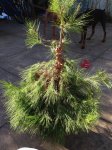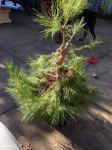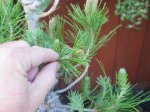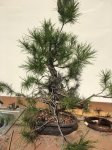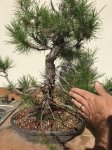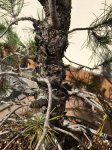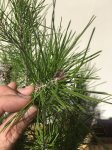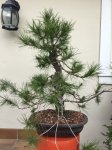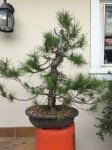You are using an out of date browser. It may not display this or other websites correctly.
You should upgrade or use an alternative browser.
You should upgrade or use an alternative browser.
ITALIAN STONE PINE; Pinus Pinea from nursery stock
- Thread starter aframe
- Start date
-
- Tags
- italian stone pine
aframe
Shohin
Vance Wood
Lord Mugo
It would be wonderful if you could find a way to reduce needle size on this tree without causing it to revert to juvenile growth. Beautiful trunk.
Potawatomi13
Imperial Masterpiece
It would be wonderful if you could find a way to reduce needle size on this tree without causing it to revert to juvenile growth. Beautiful trunk.
Seconded. And without grafting
Saizan
Yamadori
JBP has also long needles, but with the adequate work you can reduce it. The problem with other "not japanese" pine species is that you don't have too much information of how to do the appropiate works to reduce the needles without reverting to juvenile growth.
Below you have an example of works in a Pinus pinea trying the mekiri and metsumi. And sorry, it's in spanish but I think images worth the watching.
http://carthago2009.blogspot.com.es/search/label/Pino piñonero
Below you have an example of works in a Pinus pinea trying the mekiri and metsumi. And sorry, it's in spanish but I think images worth the watching.
http://carthago2009.blogspot.com.es/search/label/Pino piñonero
aframe
Shohin
The needles on the tree in the blog are cut. My experience with this sp. so far is the needles will reduce, but the follow-on bud may be weak resulting in juvenile growth. I repotted this tree last night, I'll post pics of the reduced needle size. The needles are an attractive light green, a bit lighter than my JRP. I've only had the tree for 2 years and only been pruning to chase foliage back to the trunk and thicken lower branches; I have not attempted to reduce needle size as the tree is not in that stage of development. However, shorter needles may have resulted in the apex due to hard pruning and needle pulling...may have resulted from the tree going dormant during our extremely long, hot summer this year..may have been both...JBP has also long needles, but with the adequate work you can reduce it. The problem with other "not japanese" pine species is that you don't have too much information of how to do the appropiate works to reduce the needles without reverting to juvenile growth.
Below you have an example of works in a Pinus pinea trying the mekiri and metsumi. And sorry, it's in spanish but I think images worth the watching.
http://carthago2009.blogspot.com.es/search/label/Pino piñonero
Saizan
Yamadori
The needles on the tree in the blog are cut.
Yes, they are. I shared a link to someone trying to reduce needles, not a link being success on it
In the text the author said that he was experimenting different things to reduce the needle size,. In addition, there's few information about P. pinea, so I though that could be useful.
Here is another good article that can help:
http://www.ofer-grunwald-bonsai.com/cracking-mediterranean-red-pines/
http://www.ofer-grunwald-bonsai.com/cracking-mediterranean-red-pines/
aframe
Shohin
Thank you for sharing that; I wanted to believe that my tree had 3 flushes, but since I did not uniformly work the entire tree I though my results were 'strange'. I will confirm the 3 flush growth in my area which may be similar to Mediterranean climate.Here is another good article that can help:
http://www.ofer-grunwald-bonsai.com/cracking-mediterranean-red-pines/
Wiring all the branches upward instead of ''Japanese down'' might be a good start?It would be wonderful if you could find a way to reduce needle size on this tree without causing it to revert to juvenile growth. Beautiful trunk.
https://www.google.com.au/search?q=...SABCK8Q_AUIBygB#tbm=isch&q=italian+stone+pine
In other words, If your not going to make a Stone pine, why use a Stone pine?

Last edited:
aframe
Shohin
Short needles from a late-summer candle; flanked by juvenile foliage.It would be wonderful if you could find a way to reduce needle size on this tree without causing it to revert to juvenile growth. Beautiful trunk.
Attachments
Vance Wood
Lord Mugo
It's an interesting tree that seems to do interesting things, especially with the trunk. It therefore may be worth doing a lot with. If my memory serves me correctly which seems to be an issue lately, Ernie Kuo seems to have had some success with them.
aframe
Shohin
You're right; I've looked into Kuo's work with Pinus Pinea. If my memory serves Kuo pruned to keep the Juvenile foliage on his developed trees; nevertheless interesting. We'll see how this develops in the coming years: the branches have a tendency to form large 'knots' on the trunk. If the branches are left to grow unchecked during development, the resulting knots could destroy the trunk line. I've seen 'knotting' on much of the larger nursery stock in big box stores and local vendors.It's an interesting tree that seems to do interesting things, especially with the trunk. It therefore may be worth doing a lot with. If my memory serves me correctly which seems to be an issue lately, Ernie Kuo seems to have had some success with them.
aframe
Shohin
aframe
Shohin
10/28/2017:
The foliage has a healthy, attractive green color. The buds are looking stronger this year because it's had over 1.5 years to get established in it's smaller pot.
This tree will get wired for the 1st time this fall after light pruning and needle pulling in the apex.
This species seems to push buds when cut back on thicker branches so long as there are healthy needles below the cut. The new buds will create juvenile growth, but it may be an option to push the branching back toward the trunk faster than hoping for buds to pop along the inner branching.
Another trait I'm observing is strong apical dominance - the lower branches are significantly less vigorous despite being left alone for 1.5 years. The top was much thinner, but has become obviously stronger in a relatively short time. I did not pull needles last year, so we'll see how the top can be slowed down by pulling needles this year and redirecting energy downwards.
The foliage has a healthy, attractive green color. The buds are looking stronger this year because it's had over 1.5 years to get established in it's smaller pot.
This tree will get wired for the 1st time this fall after light pruning and needle pulling in the apex.
This species seems to push buds when cut back on thicker branches so long as there are healthy needles below the cut. The new buds will create juvenile growth, but it may be an option to push the branching back toward the trunk faster than hoping for buds to pop along the inner branching.
Another trait I'm observing is strong apical dominance - the lower branches are significantly less vigorous despite being left alone for 1.5 years. The top was much thinner, but has become obviously stronger in a relatively short time. I did not pull needles last year, so we'll see how the top can be slowed down by pulling needles this year and redirecting energy downwards.
Attachments
Last edited:
Vance Wood
Lord Mugo
Honestly??? I've been growing bonsai for more than 50 years and I have never had a tree style itself. If you want to have a decent bonsai from this material you are going to have to start doing something with it, right now it looks like something other than a bonsai, the only resemblance the pot. If you need help in acquiring the skills necessary ask, someone here should be able to point you in the right direction.This tree is gonna become something, beautiful trunk and bark. Thanks for sharing experiences. How old do you think it is?
aframe
Shohin
The bark is nice and grey, with thin flakes - making it look older. I'd guess it's about 10 years old.This tree is gonna become something, beautiful trunk and bark. Thanks for sharing experiences. How old do you think it is?
Vance Wood
Lord Mugo
You need to go after the branching. After all it is the design of the branches that make the design of the tree.The bark is nice and grey, with thin flakes - making it look older. I'd guess it's about 10 years old.
aframe
Shohin
Nov 4th, 2017
1st wiring - basic movement in primary branches. The branches down low are sacrificial. There are 2 branches at the top; the smaller one has more buds, branches and short inter nodes - it will form the apex. The other taller branch has good movement, but it is sacrificial. It will be removed when there is a natural taper and transition between the middle trunk section and the top trunk section. It will also help heal the scar left from the previous leader.
1st wiring - basic movement in primary branches. The branches down low are sacrificial. There are 2 branches at the top; the smaller one has more buds, branches and short inter nodes - it will form the apex. The other taller branch has good movement, but it is sacrificial. It will be removed when there is a natural taper and transition between the middle trunk section and the top trunk section. It will also help heal the scar left from the previous leader.
Attachments
Similar threads
- Replies
- 9
- Views
- 2K

